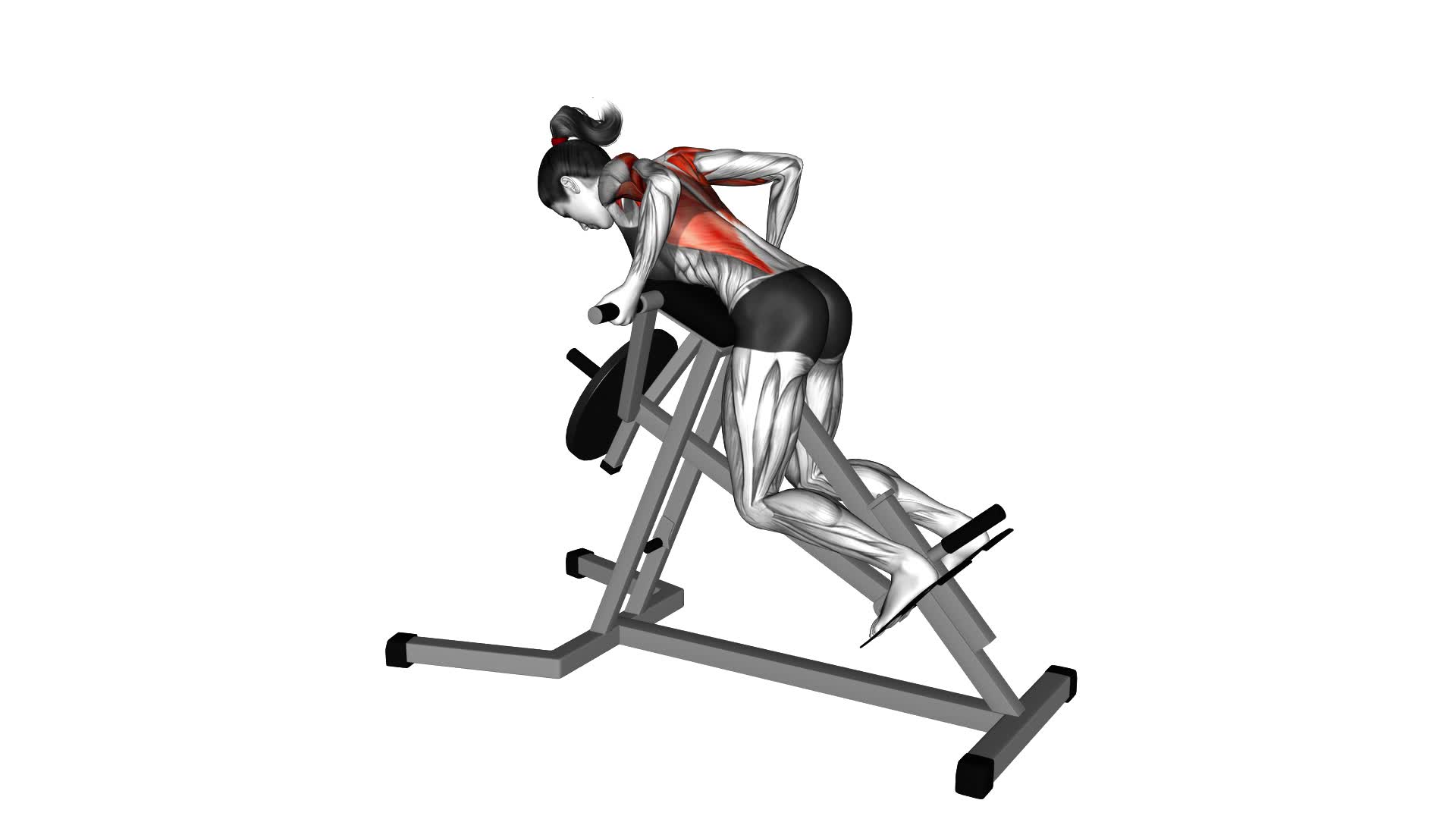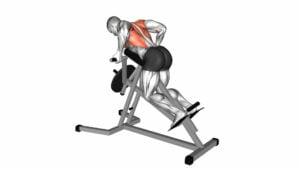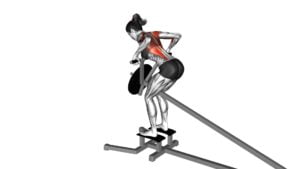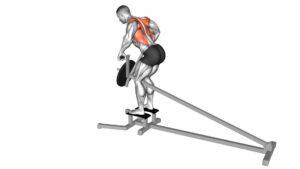Lever Reverse T-Bar Row (female) – Video Exercise Guide & Tips

Are you looking to strengthen your back muscles?
Watch This Exercise Video
Check out this video exercise guide for the Lever Reverse T-Bar Row. In just a few minutes, you'll learn proper form, equipment setup, and targeted muscles.
Plus, we'll share variations and progressions to challenge yourself. Don't miss out on these tips for maximizing your results.
Let's get started!
Key Takeaways
- Maintain proper form and technique to effectively engage target muscles and avoid injuries
- Adjust the equipment to the desired height and ensure stability before starting the exercise
- Engage back muscles including latissimus dorsi, rhomboids, and trapezius for improved posture and reduced back pain
- Incorporate variations and progressions such as one-arm lever reverse T-bar row or wide grip lever reverse T-bar row for increased intensity and muscle activation.
Proper Form and Technique
To execute the Lever Reverse T-Bar Row with proper form and technique, begin by positioning yourself in front of the lever machine. Common mistakes in this exercise include using too much momentum, rounding the back, and pulling with the arms instead of engaging the back muscles. By maintaining proper form, you can enjoy multiple benefits from this exercise.
Firstly, proper form ensures that you engage the target muscles effectively. When done correctly, the Lever Reverse T-Bar Row primarily targets the muscles of the upper back, including the rhomboids, trapezius, and rear deltoids. By using the correct technique, you can activate these muscles to their fullest potential, leading to improved strength and muscle development.
Secondly, proper form helps to prevent injuries. Incorrect form can put unnecessary strain on your back and shoulders, increasing the risk of muscle strains or even more serious injuries. By maintaining a neutral spine, keeping the shoulders back and down, and using controlled movements, you can minimize the risk of injury and ensure a safe and effective workout.
Equipment and Setup
You can set up the equipment for the Lever Reverse T-Bar Row by adjusting the lever machine to your desired height and attaching the appropriate handle or bar. Make sure the lever machine is stable and secure before starting the exercise.
The Lever Reverse T-Bar Row is a great exercise for targeting your back muscles, including the latissimus dorsi, rhomboids, and trapezius. It also works your biceps and forearms. By performing this exercise, you can improve your posture, increase back strength, and enhance overall upper body muscle development.
To set up the equipment, start by adjusting the lever machine to a height that allows you to comfortably reach the handles or bar. Attach the appropriate handle or bar to the lever machine, making sure it's securely fastened. Ensure that the equipment is in good working condition and the weight stack is set to an appropriate resistance level for your fitness level and goals.
When performing the Lever Reverse T-Bar Row, common mistakes to avoid include using too much weight, which can compromise your form and lead to injury. It's important to maintain proper posture throughout the exercise, keeping your back straight and shoulders relaxed. Avoid pulling the weight with your arms, instead, focus on using your back muscles to initiate the movement.
Take the time to set up the equipment correctly and pay attention to your form to maximize the benefits of the Lever Reverse T-Bar Row and minimize the risk of injury.
Targeted Muscles
The Lever Reverse T-Bar Row targets the back muscles, including the latissimus dorsi, rhomboids, and trapezius. This exercise provides several benefits and advantages for your overall fitness. Firstly, it helps to strengthen and tone the muscles in your back, which can improve your posture and reduce the risk of back pain. Additionally, the Lever Reverse T-Bar Row also engages the muscles in your arms, particularly the biceps and forearms, helping to increase overall upper body strength.
To get the most out of this exercise and avoid common mistakes, it's important to maintain proper form throughout the movement. One common mistake is using too much weight, which can compromise your form and increase the risk of injury. Start with a weight that allows you to perform the exercise with control and proper technique. Another mistake to avoid is rounding your back or shoulders during the movement. Keep your spine neutral and your shoulders pulled back and down to engage the targeted muscles effectively.
Remember to breathe throughout the exercise, inhaling as you lower the weight and exhaling as you lift it. By following these tips and performing the Lever Reverse T-Bar Row correctly, you can maximize the benefits and avoid potential injuries.
Variations and Progressions
As you progress in your Lever Reverse T-Bar Row training, you can explore various variations and progressions to further challenge your back muscles and enhance your overall upper body strength. Here are some advanced variations and common mistakes to be aware of:
Advanced variations:
- One-arm Lever Reverse T-Bar Row: Perform the exercise with one arm at a time to increase the intensity and engage your core for stability.
- Wide grip Lever Reverse T-Bar Row: Use a wider grip on the T-bar handle to target different areas of your back muscles.
- Pause at the top: Hold the top position for a few seconds before lowering the weight to increase time under tension and maximize muscle activation.
- Superset with other exercises: Combine the Lever Reverse T-Bar Row with other back exercises like pull-ups or lat pulldowns to create a challenging superset workout.
Common mistakes:
- Using too much weight: It's important to maintain proper form and control throughout the movement. Avoid using excessive weight that compromises your technique.
- Rounding your back: Keep your back straight and avoid rounding or arching it during the exercise. This ensures proper muscle activation and reduces the risk of injury.
- Jerking the weight: Avoid using momentum to lift the weight. Focus on a slow and controlled movement to fully engage your back muscles.
- Neglecting proper breathing: Remember to exhale as you pull the weight towards your chest and inhale as you return to the starting position. This helps maintain proper form and prevents unnecessary strain.
Tips for Maximizing Results
To maximize your results in Lever Reverse T-Bar Row training, focus on incorporating proper form and technique. However, it's also important to remember that your nutrition and diet play a crucial role in achieving your desired outcomes. Fueling your body with the right nutrients will provide the energy needed for intense workouts and aid in muscle recovery and growth.
When it comes to nutrition, make sure to consume a balanced diet that includes lean proteins, complex carbohydrates, and healthy fats. These macronutrients will supply your muscles with the necessary building blocks to repair and grow stronger. Additionally, staying hydrated is essential for optimal performance and recovery.
In addition to nutrition, adequate rest and recovery are vital for maximizing your results. Giving your body enough time to rest allows it to repair and rebuild muscle tissue, leading to increased strength and performance. Aim for 7-9 hours of quality sleep each night and incorporate rest days into your training schedule to avoid overtraining.
Frequently Asked Questions
How Many Repetitions and Sets Should I Do for the Lever Reverse T-Bar Row Exercise?
To determine the ideal number of repetitions and sets for the lever reverse T-bar row exercise, consider your fitness goals and experience level.
Generally, it's recommended to perform 8-12 repetitions for 3-4 sets to build strength and muscle.
However, you can also vary the exercise by changing your grip width, using different attachments, or adjusting the weight load.
Remember to listen to your body and progress gradually to avoid injury.
Can I Perform the Lever Reverse T-Bar Row Exercise Using Dumbbells Instead of a Barbell?
Yes, you can perform the lever reverse t-bar row exercise using dumbbells instead of a barbell.
The dumbbell variation offers the same benefits as the barbell version, such as targeting your back muscles, improving posture, and strengthening your upper body.
By using dumbbells, you can also work on each side independently, ensuring balanced muscle development.
Just make sure to maintain proper form and choose an appropriate weight to challenge yourself.
Is It Necessary to Warm up Before Performing the Lever Reverse T-Bar Row Exercise?
Before performing the lever reverse T-bar row exercise, it's important to warm up. Warming up helps increase blood flow, loosens muscles, and reduces the risk of injury. It also prepares your body for the exercise by increasing your heart rate and body temperature.
Additionally, warming up helps improve your overall performance during the workout.
When doing the lever reverse T-bar row, common mistakes to avoid include using improper form, lifting too much weight, and not engaging your core.
Can Beginners Perform the Lever Reverse T-Bar Row Exercise, or Is It More Suitable for Advanced Lifters?
Beginners can perform the lever reverse T-bar row exercise, but modifications may be necessary to ensure proper form and prevent injury. This exercise primarily targets the back muscles, promoting strength and muscle growth.
However, advanced lifters can also benefit from this exercise by increasing the weight and intensity to challenge their muscles further. It's important to start with lighter weights and gradually progress to heavier ones to avoid strain or overexertion.
What Is the Recommended Rest Time Between Sets When Performing the Lever Reverse T-Bar Row Exercise?
For optimal results, it's important to consider rest time and exercise intensity when performing the lever reverse t-bar row exercise.
Rest time refers to the amount of time you should take between sets. This allows your muscles to recover and prepare for the next set. The recommended rest time for this exercise is typically around 60-90 seconds. This will ensure that you have enough time to recover while still maintaining the intensity of the exercise.
Conclusion
In conclusion, the lever reverse T-bar row is an effective exercise for targeting and strengthening the upper back muscles. By utilizing proper form and technique, along with variations and progressions, individuals can maximize their results.
Remember to adjust the equipment and setup according to your needs and fitness level.
Incorporating this exercise into your routine can help improve posture and overall upper body strength.

Author
Years ago, the spark of my life’s passion ignited in my mind the moment I stepped into the local gym for the first time. The inaugural bead of perspiration, the initial endeavor, the very first surge of endorphins, and a sense of pride that washed over me post-workout marked the beginning of my deep-seated interest in strength sports, fitness, and sports nutrition. This very curiosity blossomed rapidly into a profound fascination, propelling me to earn a Master’s degree in Physical Education from the Academy of Physical Education in Krakow, followed by a Sports Manager diploma from the Jagiellonian University. My journey of growth led me to gain more specialized qualifications, such as being a certified personal trainer with a focus on sports dietetics, a lifeguard, and an instructor for wellness and corrective gymnastics. Theoretical knowledge paired seamlessly with practical experience, reinforcing my belief that the transformation of individuals under my guidance was also a reflection of my personal growth. This belief holds true even today. Each day, I strive to push the boundaries and explore new realms. These realms gently elevate me to greater heights. The unique combination of passion for my field and the continuous quest for growth fuels my drive to break new ground.







